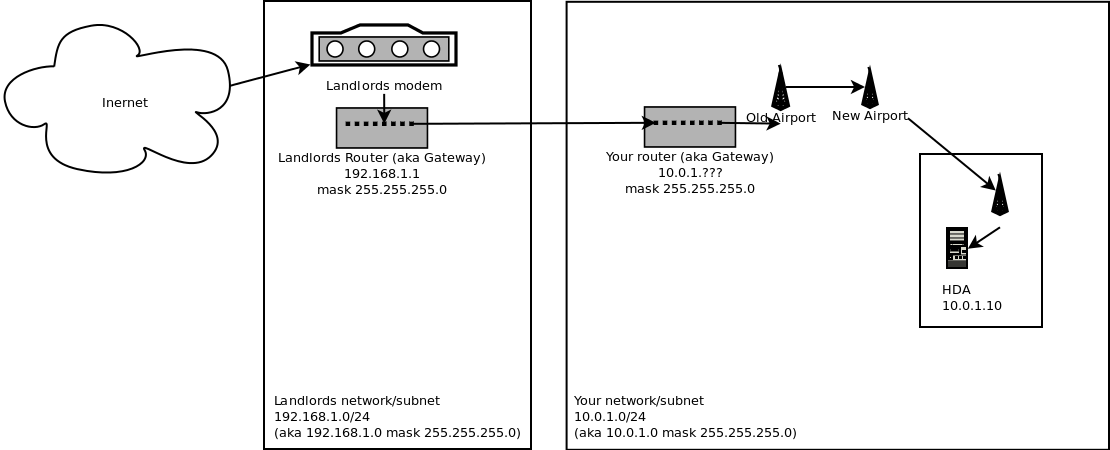Looking at your pastebin, your computer "Tower" has two gateways
Code: Select all
Destination Gateway Genmask Flags MSS Window irtt Iface
10.8.0.2 0.0.0.0 255.255.255.255 UH 0 0 0 tun0
10.0.1.0 0.0.0.0 255.255.255.0 U 0 0 0 eth0
10.8.0.0 10.8.0.2 255.255.255.0 UG 0 0 0 tun0
169.254.0.0 0.0.0.0 255.255.0.0 U 0 0 0 eth0
0.0.0.0 10.0.1.1 0.0.0.0 UG 0 0 0 eth0One at 10.0.1.1 and another 10.8.0.2, to the best of my knowledge, that just means the computer "Tower" spends a lot of time confused, but I'm not sure how it effects a Linux computer, I've only ever "achevied" that on Windows machine, and it really didn't like it.
It's from your pastebin that I also see the 10.8.0.0/24 network. However since you don't know what it is, I will ignore it for the rest of my reply
BUT it could be the source of many problems, if you can, and your sure its not needed, get rid of it from "Tower". It's associated with a network adaptor called "tun0" which strongly implies that this 10.8.0.0/24 network is somehow a VPN or some other software implemented tunnel.
What I expect Towers routing table to look like (netstat -nr) is
Code: Select all
10.0.1.0 0.0.0.0 255.255.255.0 U 0 0 0 eth0
169.254.0.0 0.0.0.0 255.255.0.0 U 0 0 0 eth0
0.0.0.0 10.0.1.1 0.0.0.0 UG 0 0 0 eth0The way you illustrate your network implies that traffic flows from your landlords router, to your router, to the b/g airpot to the n airport and then to the HDA. As per this diagram:

- ahami.png (37.5 KiB) Viewed 3113 times
Now if that's all configured correctly, that will work, but its about as inefficient a setup as you could dream up, it also seems redundant, as to act as a bridge to the b/g wireless the n wireless must also be able to talk in b/g mode, in which case just throw away from the b/g wireless and plug the n wireless into your router directly. On the other hand, I actually suspect the n wireless isnt talking to the b/g wireless at all, and is infact connected directly to your router, in which case we should just ignore your b/g wireless for this discussion as it has no role to play.
Also from your pastebin I see
Code: Select all
Step 3: Your router IP address is 10.0.1.2 and
Code: Select all
[Stecca@Tower ~]$ traceroute -q 1 -m 5 router
traceroute to router (10.0.1.1), 5 hops max, 60 byte packets
1 h001.nest.com (10.0.1.1) 0.616 msWell thats problem, you've told Ahami that your router is 10.0.1.2 but the DNS resolves your router to 10.0.1.1 (which also concurs with your routing table/netstat -nr and with your ARP table
Code: Select all
h003.nest.com (10.0.1.3) at 00:26:bb:1e:51:3c [ether] on eth0
h001.nest.com (10.0.1.1) at 00:03:93:e7:3e:c8 [ether] on eth0which shows there is a device at 10.0.1.1 but doesn't know of any device at 10.0.1.2 You need to fix that. I suggest just by telling Ahami that your router is at 10.0.1.1 and reinstalling the HDA.
If you do that, your HDA should be able to talk to the router and things will start to work.
However, there are some issues for you to think about and
perhaps resolve
1. Why are you segregating your LAN from your landlords? In the current setup, and given your landlord is no networking expert, whilst your computers and information are somewhat safe from him, you on the other hand have full and unfettered access to his network. For simplicty and ease of use, I would just use his network and forget about yours.
2. If you insist on having your network behind a firewall, you need to consider do you want to be able to connect to your network (devices on your network) from the internet? If so you got some things to do. Depending on your landlords ISP, his (or your) willingness to pay and the abilties of his router then the best solution would be to get more IP addresses assigned to his router, and then to use one of those for your LAN, and have his router direct all traffic on that IP to your router.
But that could be costly and or impossible (with your Landlords ISP, router etc) in which case you are either going to have to live without inbound services, or you are going to have to persaude your landlord to make your router his DMZ (if his router can do that) in which case any inbound traffic his router doesnt specifically recognise as being for his network, will be forward to your router, but should your landlord already have some inbound services of his own setup, then you might be out of luck unless you can move your inbound services to other ports.
Edit: switched "quote" for "code" to preserve formatting and ease of reading.